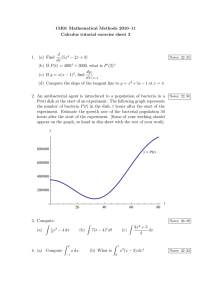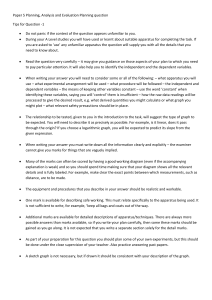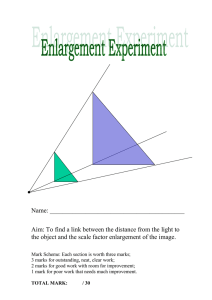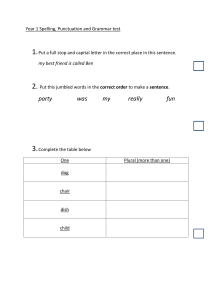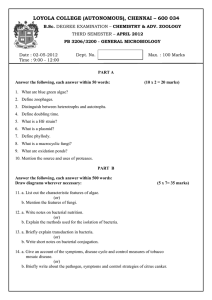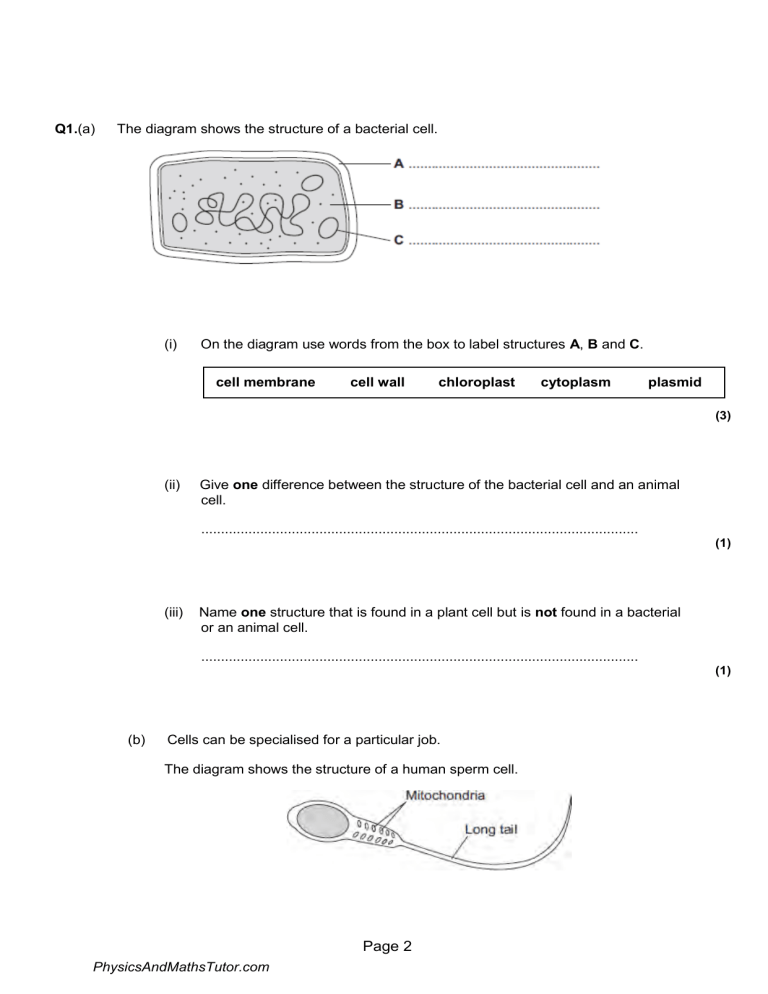
Q1.(a) The diagram shows the structure of a bacterial cell. (i) On the diagram use words from the box to label structures A, B and C. cell membrane cell wall chloroplast cytoplasm plasmid (3) (ii) Give one difference between the structure of the bacterial cell and an animal cell. ............................................................................................................... (iii) Name one structure that is found in a plant cell but is not found in a bacterial or an animal cell. ............................................................................................................... (b) (1) Cells can be specialised for a particular job. The diagram shows the structure of a human sperm cell. Page 2 PhysicsAndMathsTutor.com (1) Describe how the long tail and the mitochondria help the sperm to do its job. Long tail.......................................................................................................... ........................................................................................................................ ........................................................................................................................ Mitochondria................................................................................................... ........................................................................................................................ ........................................................................................................................ Page 3 PhysicsAndMathsTutor.com (4) (Total 9 marks) Q2.Figure 1 shows a human cheek cell viewed under a light microscope. Figure 1 © Ed Reschke/Photolibrary/Getty Images (a) Label the nucleus and cell membrane on Figure 1. (b) Cheek cells are a type of body cell. (2) Body cells grow through cell division. What is the name of this type of cell division? Tick one box. Differentiation Mitosis Specialisation (1) (c) Ribosomes and mitochondria are not shown in Figure 1. What type of microscope is needed to see ribosomes and mitochondria? ............................................................................................................................. (d) What is the advantage of using the type of microscope you named in part (c)? Page 4 PhysicsAndMathsTutor.com (1) Tick one box. Cheaper Higher magnification Lower resolution (1) (e) The cheek cell in Figure 2 is magnified 250 times. The width of the cell is shown by the line D to E. Figure 2 Calculate the width of the cheek cell in micrometres (µm). Complete the following steps. Measure the width of the cell using a ruler .......................................... mm Use the equation to work out the real width of the cell in mm: real size = ............................................ mm Convert mm to µm (f) ............................................. µm A red blood cell is 8 µin diameter. A bacterial cell is 40 times smaller. Page 5 PhysicsAndMathsTutor.com (3) Calculate the diameter of the bacterial cell. Tick one box. 0.02 µm 0.2 µm 2.0 µm 20.0 µm (1) (Total 9 marks) Page 6 PhysicsAndMathsTutor.com Q3.Students in a school investigated the effect of five different antibiotics, A, B, C, D and E, on one type of bacterium. The students: • grew the bacteria on agar jelly in a Petri dish • soaked separate paper discs in each of the antibiotics • put the paper discs onto the bacteria in the Petri dish • put the Petri dish into an incubator. The diagram shows what the Petri dish looked like after 3 days. (a) (i) What is the maximum temperature the incubator should be set at in the school? Draw a ring around your answer. 10°C25°C50°C (ii) (1) Draw a ring around the correct answer to complete the sentence. The incubator should not be set at a higher temperature because the higher pathogens. temperature might help the growth of toxins. viruses. (1) Page 7 PhysicsAndMathsTutor.com (b) Which antibiotic, A, B, C, D or E, would be best to treat a disease caused by this type of bacterium? Write your answer in the box. Give the reason for your answer. ........................................................................................................................ ........................................................................................................................ (c) (2) Antibiotics cannot be used to treat diseases caused by viruses. Why? Tick ( ) one box. Viruses are not pathogens There are too many different types of virus Viruses live inside cells (1) (Total 5 marks) Page 8 PhysicsAndMathsTutor.com Q4.The diagrams show four types of cell, A, B, C and D. Two of the cells are plant cells and two are animal cells. (a) (i) Which two of the cells are plant cells? Tick ( ) one box. A and B A and D C and D (ii) (1) Give one reason for your answer. ............................................................................................................... ............................................................................................................... Page 9 PhysicsAndMathsTutor.com (1) (b) (c) (i) Which cell, A, B, C or D, is adapted for swimming? (ii) Which cell, A, B, C or D, can produce glucose by photosynthesis? (1) (1) Cells A, B, C and D all use oxygen. For what process do cells use oxygen? Draw a ring around one answer. osmosis photosynthesis respiration (1) (Total 5 marks) Page 10 PhysicsAndMathsTutor.com Q5.The diagram shows a cell. (a) (i) Use words from the box to name the structures labelled A and B . cell membrane chloroplast cytoplasm nucleus A ....................................................... B ....................................................... (ii) (2) The cell in the diagram is an animal cell. How can you tell it is an animal cell and not a plant cell? Give two reasons. 1 ............................................................................................................ ............................................................................................................... 2 ............................................................................................................ ............................................................................................................... (b) Oxygen will diffuse into the cell in the diagram. Page 11 PhysicsAndMathsTutor.com (2) Why? Use information from the diagram. ........................................................................................................................ ........................................................................................................................ (c) (1) The cell shown in the diagram is usually found with similar cells. Draw a ring around the correct answer to complete the sentence. an organ. Scientists call a group of similar cells a system. a tissue. (1) (Total 6 marks) Page 12 PhysicsAndMathsTutor.com Q6.The diagram shows how a student transferred some sour milk from a bottle to a Petri dish of nutrient agar. List A gives four actions carried out by the student. List B gives five possible effects of these actions. Page 13 PhysicsAndMathsTutor.com Draw a straight line from each action in List A to its effect in List B. Draw only one line from each action. List A – Action List B – Effect Risk of contamination with bacteria increased Heating loop in flame Fewer bacteria will enter Placing loop on bench to cool Kills bacteria Only lifting lid of Petri dish a little Prevents air entering Placing Petri dish in incubator at 25°C Risk of growth of pathogens decreased (Total 4 marks) Page 14 PhysicsAndMathsTutor.com Q7.The image below shows some cells in the lining of the stomach. (a) (i) Use words from the box to name structures A and B. cell membrane chloroplast cytoplasm vacuole A .......................................................................... B .......................................................................... (ii) (2) What is the function of the nucleus? Tick ( ) one box. To control the activities of the cell To control movement of substances into and out of the cell To release energy in respiration (1) (b) Draw one line from each part of the human body to its correct scientific name. Page 15 PhysicsAndMathsTutor.com Part of human body Scientific name An organ Layer of cells lining the stomach An organism Stomach An organ system Mouth, stomach, intestines, liver and pancreas A tissue (3) (Total 6 marks) Page 16 PhysicsAndMathsTutor.com Q8.The diagram below shows a cell. (a) Draw a ring around the correct answer to complete each sentence. chromosomes. (i) In the nucleus of a cell, genes are part of membranes. receptors. (1) characteristics (ii) Different genes control different gametes of an organism. nuclei (1) (iii) Studying the similarities and differences between organisms allows us to classify clone the organisms. grow (1) Page 17 PhysicsAndMathsTutor.com (b) Complete the following sentence. Living things can be grouped into animals, microorganisms and ..................... . (1) (Total 4 marks) Page 18 PhysicsAndMathsTutor.com Q9.The diagram shows a method used to grow pure cultures of a bacterium. (a) Name apparatus A and apparatus B. Apparatus A ............................................................... Apparatus B ............................................................... (b) (i) (2) Why should apparatus A and apparatus B be sterilised before they are used? ............................................................................................................... ............................................................................................................... (ii) How should apparatus A be sterilised? Tick ( ) one box. Using enzymes Page 19 PhysicsAndMathsTutor.com (1) Using a flame In an incubator (1) (iii) Adhesive tape is used to secure the lid on apparatus B. Give one reason why the lid of apparatus B should be securely taped in place. ............................................................................................................... ............................................................................................................... (c) (1) What is the maximum temperature that should be used in schools to grow the bacteria in apparatus B? Draw a ring around the correct answer. 10 °C 25 °C 50 °C (1) (Total 6 marks) Page 20 PhysicsAndMathsTutor.com Q10.Human cells and yeast cells have some parts that are the same. (a) The diagram shows a yeast cell. Parts A and B are found in human cells and in yeast cells. On the diagram, label parts A and B. (b) (2) Many types of cell can divide to form new cells. Some cells in human skin can divide to make new skin cells. Why do human skin cells need to divide? ........................................................................................................................ ........................................................................................................................ (c) (1) Human stem cells can develop into many different types of human cell. (i) Use the correct answer from the box to complete the sentence. embryos hair nerve cells Human stem cells may come from ............................................................................................................... Page 21 PhysicsAndMathsTutor.com (1) (ii) Use the correct answer from the box to complete the sentence. cystic fibrosis paralysis polydactyly Human stem cells can be used to treat ............................................................................................................... Page 22 PhysicsAndMathsTutor.com (1) (Total 5 marks)


